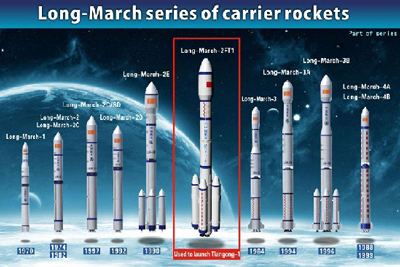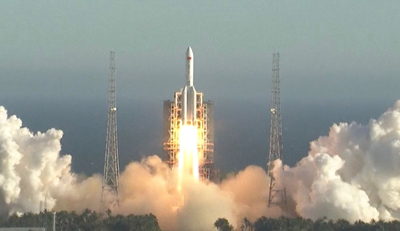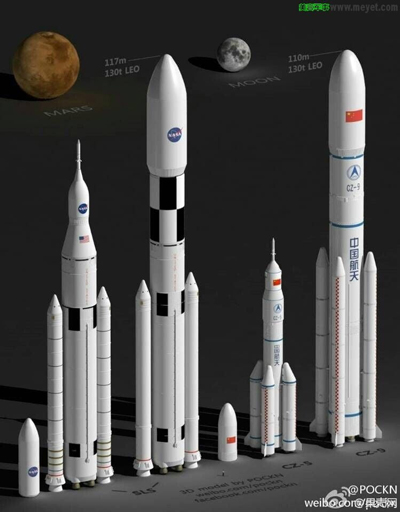Long March
Long March (Rocket Family)
- The Long March rockets are a family of expendable launch system rockets operated by the China Aerospace Science and Technology Corporation. The rockets are named after the Chinese Red Army‘s 1934–35 Long March military retreat during the Chinese Civil War.
- The Long March series has performed more than 450 launches, including missions to low-Earth orbit (LEO), sun-synchronous orbit (SSO), geostationary transfer orbit, and Earth-moon transfer orbit.
History
- China used the Long March 1 rocket to launch its first satellite, Dong Fang Hong 1, into low Earth orbit on 24 April 1970, becoming the fifth nation to achieve independent launch capability.
- Early launches had an inconsistent record, focusing on the launching of Chinese satellites.
- The Long March 1 was quickly replaced by the Long March 2 family of launchers.
Entry into commercial launch market
- After the Space Shuttle Challenger was destroyed in 1986, a growing commercial backlog gave China the chance to enter the international launch market.
- In September 1988, S. President Ronald Reagan agreed to allow U.S. satellites to be launched on Chinese rockets. Reagan’s satellite export policy would continue to 1998, through Bush and Clinton administrations, with 20 or more approvals.
- However, major setbacks occurred in 1992–1996. The Long March 2E was designed with a defective payload fairing, which collapsed when faced with the rocket’s excessive vibration. After just seven launches, the Long March 2E destroyed the Optus B2 and Apstar 2 satellites and damaged AsiaSat 2.
- The Long March 3B also experienced a catastrophic failure in 1996, veering off course shortly after lift off and crashing into a nearby village, the Intelsat 708 satellite being destroyed.
- Six Long March rockets (Chang Zheng 2C/SD) launched 12 Iridium satellites, a sixth of Iridium satellites in the fleet.
United States embargo on Chinese launches
- The involvement of United States companies in the Apstar 2 and Intelsat 708 investigations caused great controversy in the United States. In the Cox Report, the United States Congress accused Space Systems/Loral and Hughes Aircraft Company of transferring information that would improve the design of Chinese rockets and ballistic missiles. Although the Long March was allowed to launch its commercial backlog, the United States Department of State has not approved any satellite export licenses to China since 1998.
- From 2005 to 2012, Long March rockets launched ITAR-free satellites made by the European company Thales Alenia Space. However, Thales Alenia was forced to discontinue its ITAR-free satellite line in 2013 after the United States State Department fined a United States company for selling ITAR components.
Return to success
- From October 1996 to April 2009, the Long March rocket family delivered 75 consecutive successful launches, including several major milestones in space flight.
- On 15 October 2003, the Long March 2F rocket successfully launched the Shenzhou 5 spacecraft, carrying China’s first astronaut into space. China became the third nation with independent human spaceflight capability, after the Soviet Union/Russia and the United States.
- On 1 June 2007, Long March rockets completed their 100th launch overall.
- On 24 October 2007, the Long March 3A successfully launched (10:05 UTC) the “Chang’e 1” lunar orbiting spacecraft from the Xichang Satellite Launch Center.
- The Long March rockets have subsequently maintained an excellent reliability record. Since 2010, Long March launches have made up 15–25% of all space launches globally.
Propellants
- Long March 1‘s 1st and 2nd stage used nitric acid and Unsymmetrical dimethylhydrazine (UDMH) propellants, and its upper stage used a spin-stabilized solid rocket engine.
- Long March 2, Long March 3, Long March 4, the main stages and associated liquid rocket boosters use dinitrogen tetroxide (N2O4) as the oxidizing agent and UDMH as the fuel. The upper stages (third stage) of Long March 3 rockets use YF-73 and YF-75 engines, using Liquid hydrogen (LH2) as the fuel and Liquid oxygen (LOX) as the oxidizer.
- The new generation of Long March rocket family, Long March 5, and its derivations Long March 6, Long March 7 use LOX and kerosene as core stage and liquid booster propellant, with LOX and LH2in upper stages.
- Long March 11 is a solid-fuel rocket.
Long March 8
- The Long March 8 is a new series of launch vehicles, which is geared towards Sun-synchronous orbit (SSO) launches. It was expected to be based on the Long March 7, and have two solid fuel boosters, with first launch by the end of 2018.
- By 2019, it was intended to be partially reusable. The first stage will have legs and grid fins (like Falcon 9) and it may land with side boosters still attached.
- The first Long March 8 was rolled out to for a test launch on 20 December 2020 and launched on 22 December 2020. The second flight with no side boosters occurred on 27 February 2022, sending a national record of 22 satellites into SSO.
Long March 9
- The Long March 9 (LM-9, CZ-9, or Changzheng 9, is a Chinese super-heavy carrier rocket concept proposed in 2018 that is currently in study.
- It is planned for a maximum payload capacity of 140,000kg to low Earth orbit (LEO), 50,000kg to trans-lunar injection or 44,000kg to Mars. Its first flight is expected by 2028 in preparation for a lunar landing sometime in the 2030s; a sample return mission from Mars has been proposed as first major mission.
- The 2011 proposed design would be a three-staged rocket, with the initial core having a diameter of 10 meters and use a cluster of four engines.
- Multiple variants of the rocket have been proposed, CZ-9 being the largest with four liquid-fuel boosters with the aforementioned LEO payload capacity of 140,000kg, CZ-9A having just two boosters and a LEO payload capacity of 100,000kg, and finally CZ-9B having just the core stage and a LEO payload capacity of 50,000kg.
- Approved in 2021, the Long March 9 is classified as a super heavy-lift launch vehicle.
Launch sites
There are four launch centres in China:
- Most of the commercial satellite launches of Long March vehicles have been from Xichang Satellite Launch Center, located in Xichang, Sichuan
- Wenchang Spacecraft Launch Site in Hainan province is under expansion and will be the main launch centre for future commercial satellite launches.
- Long March launches also take place from the more military oriented Jiuquan Satellite Launch Center in Gansu province from which the crewed Shenzhou spacecraft also launches.
- Taiyuan Satellite Launch Center is located in Shanxi province and focuses on the launches of Sun-synchronous orbit (SSO) satellites.
- On 5 June 2019, China launched a Long March 11 rocket from a mobile launch platform in the Yellow Sea.



